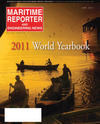
Page 8: of Maritime Reporter Magazine (June 2011)
Feature: Annual World Yearbook
Read this page in Pdf, Flash or Html5 edition of June 2011 Maritime Reporter Magazine
The amount of capability that you get at sea today for the dollars that you spend is tremendous compared to what you got 25 years ago. Thats driven by technol- ogy and capital investments, as well as investments that weve made in the people that do the work. This capabil- ity makes the Navy more relevant that it has ever been. What do you consider to be your greatest accomplishment in your career? Petters You know, I dont know how to answer that question. I come to work every day looking for an op- portunity to support our customers, to give our ship- builders a chance to do their very best work, and to make sure that we are good stewards of both taxpayers dollars and of shareholder investments. If the team does well, I feel very satisfied with that; I feel accountable if the team comes up short. Thats made for a very rewarding career in a very tough industry. When did you realize that maritime would become a career for you? Petters Thats a good question. The legend around the shipyard is that when you buy your second set of steel toes thats when it becomes a career for you. I was in the Navy before I came to the shipyard, and I cant say that I really aspired to be in a shipyard, because I was actually in a shipyard in the Navy, and I had a few options when I came out. What Ive found inside the shipyards is that you have a chance to do something where you grow everyday, youre part of something that is much bigger than yourself, and when you wake up in the morning you want to go to work because you are surrounded by peo- ple who have a passion for what they are doing. These folks in this business ? across this industry, frankly ? they come to work everyday with the opportunity to use their heads, their hands and their hearts to do somethingthat is in the national interest; and I just get excited by that. I dont know that I ever made the decision that I wanted to be in the maritime industry, I found myself in the industry and I love every minute of it. What do you consider the biggest two or three challenges to running a successful, efficient shipbuilding operation? Petters Were going to have to accelerate our thinking of shipbuilding as a process that has lots of players. As a result, there are lots of well-understood techniques to un-derstand the value stream, to do value stream mapping and to improve the efficiencies of those value streams. I think were going to have to do that given the environ- ment that the nation is going through, relative to its fis- cal issues. The chairman of the joint chiefs has talked about our fiscal issues being a huge security risk for the country. I dont think its any secret that were going to have to figure out how to do what we do better and more affordably. The people that are able to do that, in the end, will be successful. Also, the health of any company is de- fined by its ability to attract talent, to attract technology and to attract capital. And healthy companies are able to do all three of those things, and when youre not able to do that, then the company starts to falter. And so, we spend a considerable amount of our energy working those three issues to make sure that we are able to attract cap- ital and talent that we need and that we understand tech-nologies that we need to invest in. They can be shipboard capabilities or they can be production technologies; in ei- ther case, thats a sign of a healthy company. Those have been the issues for any company in any industry for a long time, and I think that will continue to be the casegoing forward. How is HII investing today? Petters Weve been investing significantly in our facil- ities. In the past decade weve invested over $1B of cap- ital into our principal shipbuilding facilities to prepare them for the production challenges of the future. We in- vest heavily in our people, in terms of training, our ap- prentice programs, our workforce development partnerships with various states. And we keep our eyes on, and keep thinking about technologies we need rela- tive to where we think the fleet requirements are going to go in the future. The chairman of the joint chiefs has talked about our (countrys) fiscal issues as being a huge security risk for the country. I dont think its any secret that were going to have to figure out how to do what we do, better, and more affordably. The people that are able to do that, in the end, will be successful. Mike Petters The aircraft carrier USS George H.W. Bush (CVN 77) transits the Atlantic Ocean on October 10, 2010.(U.S. Navy photo by Mass Communication Specialist 3rd Class Nicholas Hall/released) The fast attack submarine USS Texas (SSN 775), on alpha sea trials, May 18, 2006. (Photo by Chris Oxley)

 7
7

 9
9
